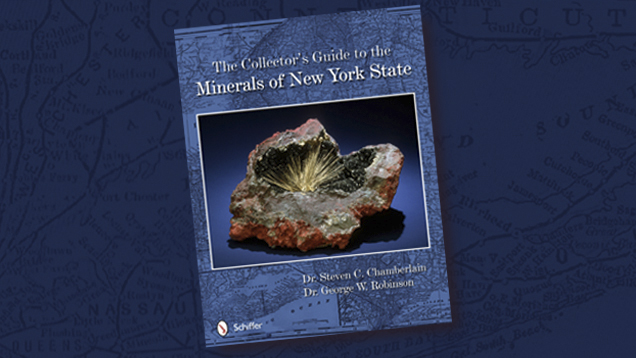Books: The Collector's Guide to the Minerals of New York State
May 6, 2014

In the introduction, the first of four chapters, Chamberlain and Robinson provide a brief positioning of the mineral sources of New York State. While there are no localities as important as Mont Saint-Hilaire in nearby Canada or Franklin, New Jersey, but it is of note that (starting with warwickite in 1838) twelve new mineral species have been discovered in New York. Some have become world-famous for their beauty, like the Herkimer diamonds, which could soon be designated as the official state mineral.
The authors devote an entire page to the important collections and collectors of New York minerals since the early 19th century, but only one page of text (plus ten references) to the geology of New York State. The other pages of this sub-section contain beautiful photos, though most do not contribute much to the illustration of the subject. The most important geological takeaway is that almost all mineralogically interesting occurrences are found in either sedimentary or crystalline rocks and in fractures within these rocks.
The following chapters are devoted to the description of the mineral occurrences. In contrast to conventional field guides, which are usually organized geographically, this book groups the localities according to the geology of the host rocks: occurrences in sedimentary rocks, in crystalline rocks, and in fractures. This is perhaps the most unique feature of the book. The description of each locality discusses the same aspects: its significance to specimen mineralogy, its location and history, its geological setting and origin, and the relevance of the minerals to collectors. Each chapter ends with a listing of similar occurrences (with GPS coordinates) and references.
As both authors are recognized as specialists in New York minerals, these chapters are a treasure trove of information, especially as they attached importance to include the latest research results and modern mineral nomenclature (e.g., the brown tourmaline from Bush Farm has now been identified as fluoruvite).
The authors claim that the guide’s organization is “a new approach that brings coherence to relationships among similar localities.” This seems plausible and is certainly true to some extent, as the relations between similar occurrences become more visible. My overall impression, however, is that the advantages of this approach do not reach as far as the authors probably hoped.
Apart from minor criticisms (What is the interest of the lengthy enumeration of collections and collectors? Shouldn’t the part on geology be elaborated a little more, especially as the basic approach of the book is based on it?) one question immediately comes to mind: Can the minerals of an entire state be adequately described in just 96 pages, a quarter of which is filled with (admittedly beautiful) color photos? Obviously, the authors recognized this and chose to limit themselves to the most important occurrences: While this book is too incomplete to serve as a field guide or to act as a comprehensive local mineralogy text, its merit lies in the attempt at a new approach, the well-written and up-to-date text and the sheer beauty of the photos.
About the Author
Rolf Tatje is an amateur gemologist and a teacher of English and French. He holds a Ph.D. in contrastive linguistics from Gerhard Mercator University in Duisburg, Germany, and works as a freelance translator.



